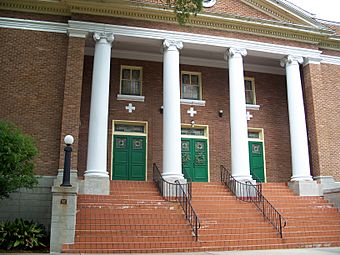Lake Eola Heights Historic District facts for kids
Quick facts for kids |
|
|
Lake Eola Heights Historic District
|
|

Church in the district
|
|
| Location | Orlando, Florida |
|---|---|
| NRHP reference No. | 91001912 |
| Added to NRHP | January 16, 1992 |
Imagine stepping back in time! The Lake Eola Heights Historic District is a special area in Orlando, Florida. It's like a living museum, filled with old buildings that tell stories about the past. This district was officially recognized as a historic place on January 16, 1992.
You can find this unique neighborhood in the eastern part of Downtown Orlando, Florida. It's generally bordered by Hillcrest Street, North Hyer Avenue, Ridgewood Street, and North Magnolia Avenue. This historic district is home to nearly 500 buildings that have been preserved because of their historical importance.
Contents
A Look Back in Time
The story of Lake Eola Heights began with a man named Jacob Summerlin. He was a citrus grower and also served as Orlando's first city council president. In the late 1800s, he bought a large piece of land here, about 200 acres.
The Great Freeze and New Homes
Jacob Summerlin's citrus farm faced a big challenge. The Great Freeze of 1894-1895 was a very cold period that damaged many orange groves in Florida. This freeze unfortunately ended Summerlin's citrus business in this area. After that, his large property was divided into smaller plots. These plots were then sold for people to build homes. This is how the neighborhood started to grow!
Architectural Styles You Can See
As homes were built, different styles of architecture became popular. Walking through Lake Eola Heights is like seeing a timeline of building designs. You can spot many interesting styles, including:
- Farmhouse: Simple, classic homes often found on farms.
- Colonial Revival: Buildings that look like they're from early American history.
- Craftsman: Homes with natural materials and handcrafted details.
- Mediterranean Revival: Buildings inspired by Spanish and Italian designs, often with red tile roofs.
- Mission Revival: Similar to Mediterranean, but with a focus on simple, smooth walls and arched openings.
- Art Deco: Buildings with geometric shapes and decorative patterns, popular in the 1920s and 30s.
- Minimal Traditional: Simpler homes built after the Art Deco period, often with fewer decorations.
Protecting History
The people living in Lake Eola Heights cared a lot about their neighborhood's history. They wanted to make sure these special buildings were protected for the future.
Local Recognition
In 1989, the residents formed the Lake Eola Heights Historic Neighborhood Association. This group worked hard to get their neighborhood recognized. They asked the City of Orlando to declare it a local historic district. The city agreed, which was a big step!
National Recognition
Just three years later, in 1992, the neighborhood received even more recognition. It was added to the National Register of Historic Places. This is a list of places across the United States that are important to the country's history. Being on this list helps protect the district and highlights its value.



